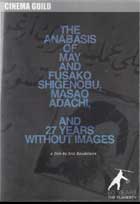
The Anabasis of May and Fusako Shigenobu, Masao Adachi, and 27 years without images 2013
Distributed by Cinema Guild, 115 West 30th Street, Suite 800, New York, NY 10001; 212-685-6242
Produced by Eric Baudelaire
Directed by Eric Baudelaire
DVD , color and b&w, 85 min.
College - General Adult
Asia, Communism, Documentaries, Emigration, Films, Global Issues, History, Human Rights, International Relations, Middle East
Date Entered: 09/15/2015
Reviewed by Jason R. Harshman, University of IowaThe narrators, May Shigenobu and Masao Adachi, are heard throughout the film but never appear on screen. Their voiceovers provide context and background for their lives as members of the Japanese Red Army as the audience is presented with archival footage and photographs of Lebanon and Japan across 30 years. May Shigenobu, daughter of the founder of the Japanese Red Army Fusako Shigenobu, offers an insider’s view on being Japanese in Lebanon and the surveillance of her family and friends, particularly her mother. Masao’s contribution is a blending of narration about how his films served as counter narratives to the policing of citizens by the Japanese government and discussion of excerpts from his films included in this documentary film. Both offer insight into the oppressive power structure that permeated large urban areas of Japan during the 1970s and the genealogy of the Japanese Red Army they each belonged to, though they lived in two different countries.
Viewers are 30 minutes into the film before a 1972 report given by a French news anchor offers the first explanation of how the Japanese Red Army gained international notoriety. The news anchor reports that Japanese Communists stormed the French Embassy at The Hague, capturing the Ambassador and 8 staff members. The news story includes discussion of a “massacre” at the Lod airport in Tel Aviv in May 1972 during which 26 people were killed and 75 were injured. After a brief history lesson told through archival news footage from 1972, the film returns to voice over narration and archival footage as each narrator discusses the growing tensions surrounding members of the Red Army in Tokyo, Japan and Beirut, Lebanon.
As one watches this film, you cannot help but notice that the director, Eric Baudelaire, in telling a story that spans 30 years and two countries, is also paying homage to Adachi’s film making style. Baudelaire’s style and inclusion of clips from Adachi’s films—each one offering an anti-establishment message aimed at government officials and stylistically, at mainstream approaches to film making—demonstrates that the mode of story telling (film) cannot be detached from the political events in which they are grounded. The story unfolds slowly and the decision to use 8mm archival footage requires patience from the viewer. Viewers interested in film studies will likely take more away from this film than those looking to investigate the history of the communist movement in Japan during the end of the 20th century.